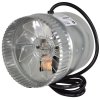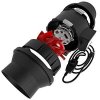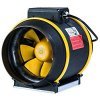so im about to start a new grow soon and i tried to correct some issues i had on previous failed grow, i have placed an 120mm intake fan wich provides my 80-80-180 tent with fresh air from out side, my exhaust fan is 100mm though, and as i been told i need to see suction on my tents sides, in my case the tent is not sucked but a liltle puffed, do i need the negative pressure in my tent? shall i place a bigger 120mm exhaust fan too? or my plants will do ok with the plenty of fresh air? thank u in advance
grow nub needs ventilation advice
- Thread starter soulfly78
- Start date
coreywebster
Well-Known Member
Negative pressure is a good sign your not pushing unclean air out , positive is the opposite.
Likely you don't need the intake fan.
Likely you don't need the intake fan.
DCcan
Well-Known Member
What do you have for filter( if any) and what do the fans look like? And what do you have for circulating air inside the tent, and what kind of light...LED, HPS?
We need to see what you have to give any meaningful advice.
This is in-line fan, useless for an in-line filter exhaust, fine for intake or no-filter exhaust.

This is a centrifugal fan, may be rated for same volume of air, but this generates enough pressure to suck air thru the filter.
This is what you need, more than likely. That and a nice rotating fan inside the tent should be plenty if you are running a filter

We need to see what you have to give any meaningful advice.
This is in-line fan, useless for an in-line filter exhaust, fine for intake or no-filter exhaust.

This is a centrifugal fan, may be rated for same volume of air, but this generates enough pressure to suck air thru the filter.
This is what you need, more than likely. That and a nice rotating fan inside the tent should be plenty if you are running a filter

Renfro
Well-Known Member
Agreed, I call those duct restrictors. lol
Bigdickbigbud
Member
so im about to start a new grow soon and i tried to correct some issues i had on previous failed grow, i have placed an 120mm intake fan wich provides my 80-80-180 tent with fresh air from out side, my exhaust fan is 100mm though, and as i been told i need to see suction on my tents sides, in my case the tent is not sucked but a liltle puffed, do i need the negative pressure in my tent? shall i place a bigger 120mm exhaust fan too? or my plants will do ok with the plenty of fresh air? thank u in advance
How To Choose The Extractor Fan
This tool, calculates air exchanges and cubic m3/h to be able to choose the extractor fan for your forced ventilation in your grow box, house or bathroom.
Go to this website and calculate the size of the space Vs the extraction size so that u know the exact requirements needed to move the air around for your size space. It takes all the guesswork out of this whole thing and will help you to understand yourself the principle purpose behind why u need the things you have purchased or will purchase.
coreywebster
Well-Known Member
Use the biggest for extraction then and smallest for intake if you feel you need it.both are inline fans, but intake is wider , no filter needed i live in the f@ckin nowhere lol
Bigdickbigbud
Member
He just needs to do the calculation and he will know how much air he is able to move singularly and combined and how much air is held av. In the space... Isn't this issue resolved?If those are the crappy in line style fans then you might want to use both for exhaust, each with it's own port in the top of the tent, like one on each side. Then have at least 2x the total exhaust duct area as open as passive intakes down low.
OzyM8
Well-Known Member
Best practice is to filter your intake air also. Many ways to do it from a simple bug screen (specific for tent / room intakes), some also come with added carbon, to a carbon filter like the phresh intake filters, or normal carbon filters. Keeps out the nasties, bugs n all types of crap in the air.both are inline fans, but intake is wider , no filter needed i live in the f@ckin nowhere lol
The reason you’ve got positive pressure (tent puffing out) is that your pulling more air in faster than extracting out. I.e intake larger than outlet. Ideally you want it the other way around. Unless you’re setting positive pressure so that when a tent or room door is opened it pushes air out and doesn’t suck it into the grow from an unfiltered area. Most tent growers set for negative pressure for stealth related to smell.
Also inline fans are exactly what their name implies, really only meant to assist inline like a long duct run, and like axial fans no good for intake n extraction with filters. You want a centrifugal or mixed flow fan with using filters.
For your 800x800x1800mm, and I’d recommend using filters, you want something like a canfan rs 100 for intake and a canfan rs 125 or 150 for exhaust. Something like this would give you approx .6-.8 of a minute air exchanges....ideal for a small tent.
Edit: And just in case you’re not aware, you want your intake air positioned low - floor level, and extraction high- roof... ideally diagonally opposite.
Last edited:
coreywebster
Well-Known Member
Not really no, that's for air exchange (maintaining co2) and it doesn't even take into account temp rise above ambient.He just needs to do the calculation and he will know how much air he is able to move singularly and combined and how much air is held av. In the space... Isn't this issue resolved?
Nearly all those online calcs are the same, yet if a man lives in Alaska how can it be the same air exchange as a man living in Nevada both using the same light and space.
This would be more accurate
Calculating the airflow required to maintain a stable temperature, and so determine the size of fan needed, is surprisingly simple.
It boils down to CFM = 3.16 x Watts / DT(°F)
Watts is the lighting power (and any other 'hot' things in the grow space) in Watts.
DT is the allowable temperature rise within the enclosure (i.e. desired temperature minus ambient temperature) in °F.
To work out the size of fan required (in CFM) simply plug your lighting Wattage into the equation along with the DT value.
An example is:
Ambient temerature = 20 °C
Target temperature of the enclosure = 25 °C
DT in °C = 25 - 20 = 5
DT in °F = 5 x (9 / 5) = 9
Lighting Wattage = 250 Watts
Plugging these values into the equation gives:
CFM = 3.16 x 250 / 9 = 87.77
This represents the actual throughput required but it doesn't take account of the static pressure necessary to overcome the system impedance (how hard the fan has to suck or blow). But for a free-air system with no ducting or filters it should be fairly accurate.
coreywebster
Well-Known Member
There are many types of inline fan, your talking about duct boosters, axial fans are fine if they made for the job.Also inline fans are exactly what their name implies, really only meant to assist inline like a long duct run, and like axial fans no good for intake n extraction with filters. You want a centrifugal or mixed flow fan with using filters.
A canfan is an axial fan because the airflow moves along the axis of the fan, that's what an axial fan is. where a centrifugal fan sucks air in at the axis and pushes it out the other direction.
OzyM8
Well-Known Member
Thanks for the formula in your other post. It’s different than other formulas I’ve used.There are many types of inline fan, your talking about duct boosters, axial fans are fine if they made for the job.
A canfan is an axial fan because the airflow moves along the axis of the fan, that's what an axial fan is. where a centrifugal fan sucks air in at the axis and pushes it out the other direction.
The Canfan RS I referred to is a centrifugal, if not someone should call out its manufacturers for false advertising.
Last edited:
DCcan
Well-Known Member
Larger motor, more aggressive blade design, Vivosun has an AC infinity knockoff now. Doubt its a DC motor though.
You can see the design differences to compress the air compared to regular Axial fans.
Mostly , its the reduced noise, size and energy efficiency of some that's attractive.

The Vortex axial fans are made by a enormous Chinese fan company, and imported/rebranded, you can find them on Alibaba from manufacturer at a good price. They have a fancy outer cover, different blade design under the hood, not impressed but people are happy with them.

Can-Fan also has an efficient Axial design, quieter due to reduced turbulence vs centrifugal.
Can-Fans use good bearings, long life units generally

You can see the design differences to compress the air compared to regular Axial fans.
Mostly , its the reduced noise, size and energy efficiency of some that's attractive.

The Vortex axial fans are made by a enormous Chinese fan company, and imported/rebranded, you can find them on Alibaba from manufacturer at a good price. They have a fancy outer cover, different blade design under the hood, not impressed but people are happy with them.

Can-Fan also has an efficient Axial design, quieter due to reduced turbulence vs centrifugal.
Can-Fans use good bearings, long life units generally

Last edited:
OzyM8
Well-Known Member
I’m using the Q Max EC in my room and they’re great. Sealed room, so only running it on the schedule I need at the time. Quiet and shifts a lot of air.Larger motor, more aggressive blade design, Vivosun has an AC infinity knockoff now. Doubt its a DC motor though.
You can see the design differences to compress the air compared to regular Axial fans.
Mostly , its the reduced noise, size and energy efficiency of some that's attractive.
View attachment 4444659
The Vortex axial fans are actually made by a enormous Chinese fan company, and imported/rebranded, you can find them on Alibaba at a good price. They have a fancy outer cover, don't see that sophistication under the hood but people are happy with them.
View attachment 4444662
Can-Fan also has an efficient Axial design, quieter due to reduced turbulence vs centrifugal
View attachment 4444670
Last edited:
DCcan
Well-Known Member
Nice unit, didnt know they existed. (never scrolled beyond $200I’m using the Q Max EC in my room and they’re great. Sealed room, so only running it on the schedule I need at the time. Quiet and shifts a lot of air.
 lol)
lol)EC motor, compact size, awesome bearings, and engineered dampening...good as it gets.
It doesn't have to spin half a kilo of iron to generate wind like a centrifugal, just has to spin a bit faster
OzyM8
Well-Known Member
Lol...I’ve been growing for 35 years on and off, and done it on a shoe string budget outdoors n indoors. Finally thought f’it, if I can’t put money into a good room now then I never will. So bit the bullet and finally did it. Yeah they’re not cheap, but this build wasn’t about being cheap.Nice unit, didnt know they existed. (never scrolled beyond $200lol)
EC motor, compact size, awesome bearings, and engineered dampening...good as it gets.
It doesn't have to spin half a kilo of iron to generate wind like a centrifugal, just has to spin a bit faster


